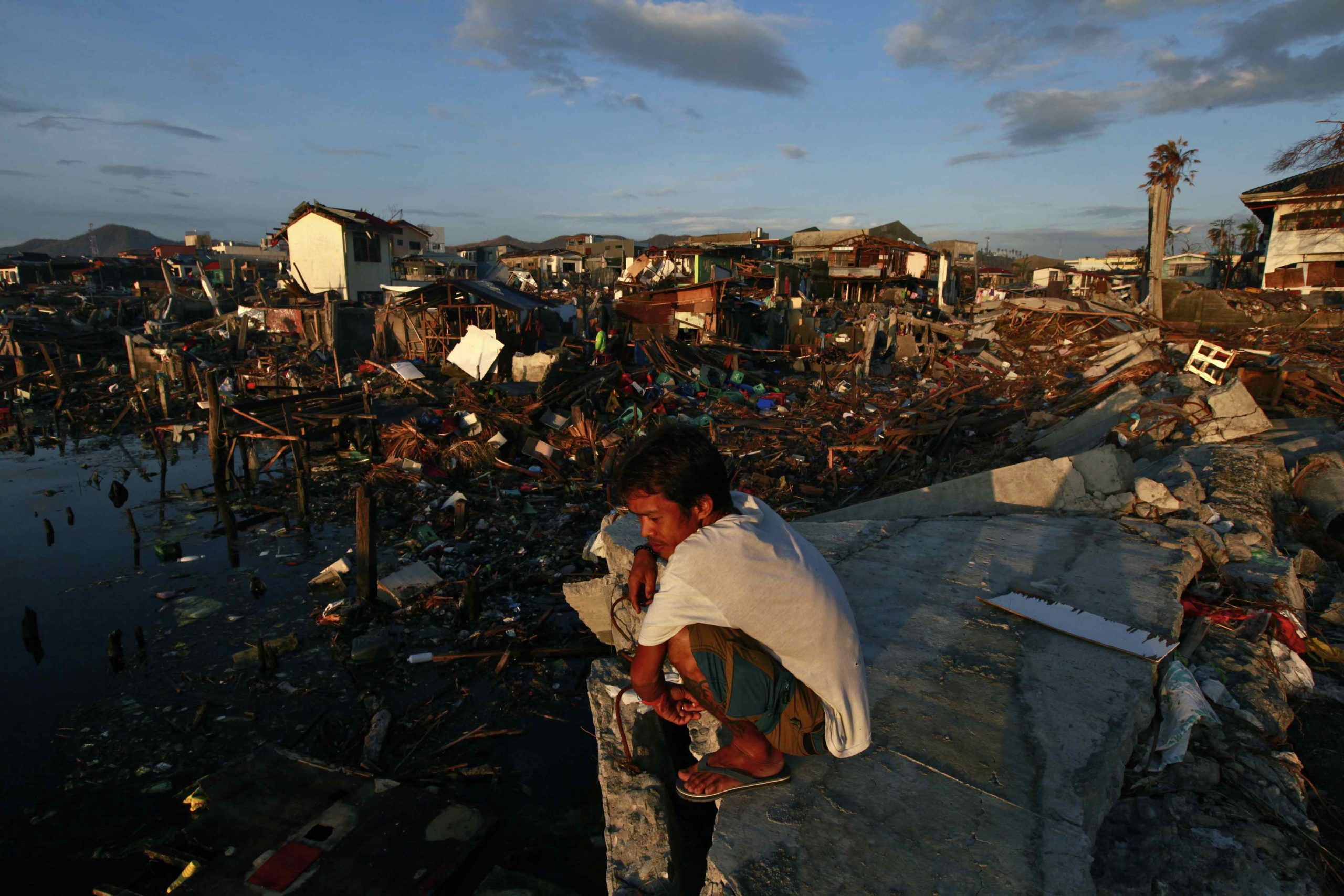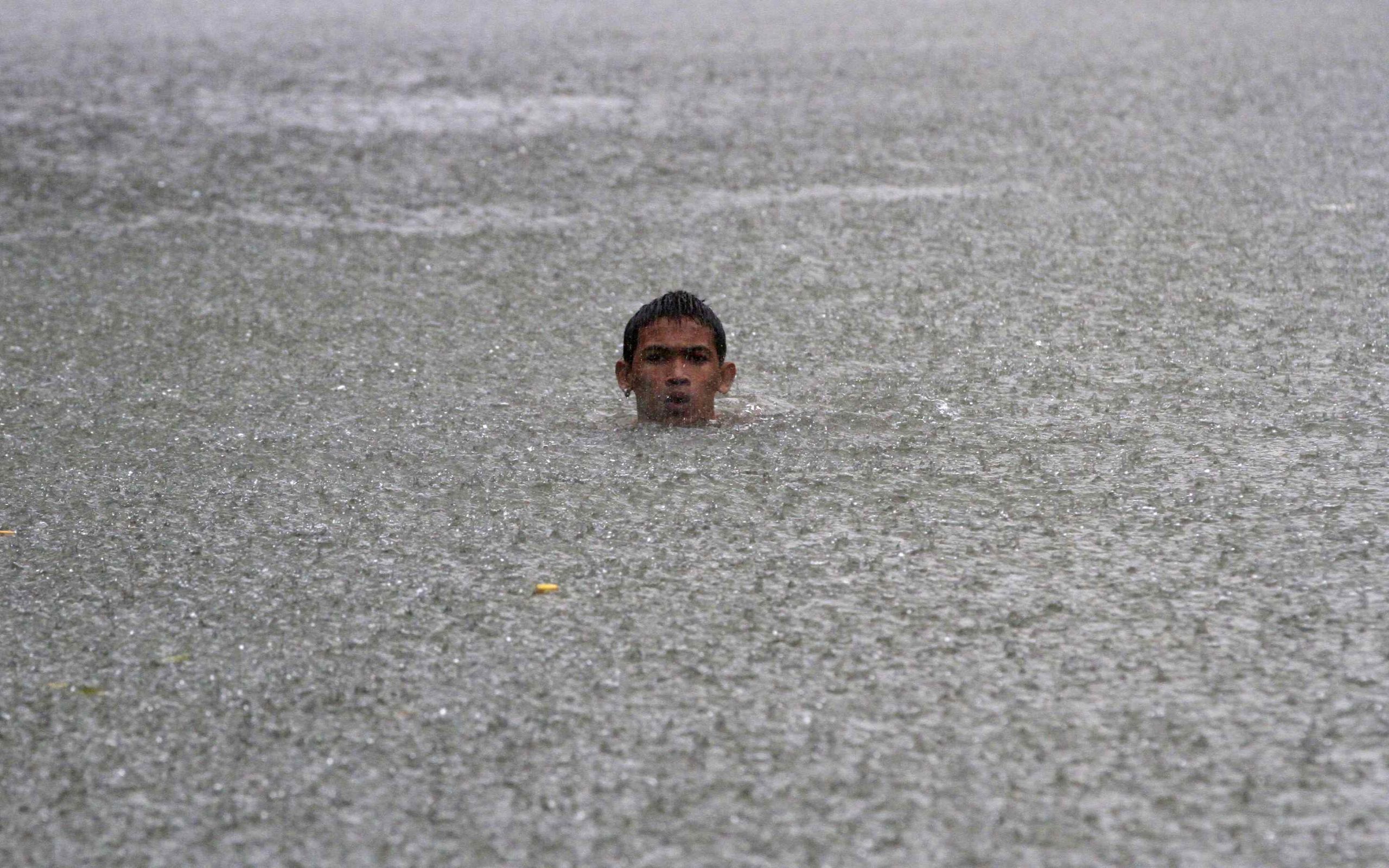By Estrella Torres
Philippine Center for Investigative Journalism

A resident of Magallanes Drive in Barangay Sto. Nino, Tacloban City sat and watched the devastation brought by Typhoon Yolanda in his community. Photograph: Bernard Testa
The coastal towns of Dolores and Sulat in Eastern Samar constantly battle with the impact of extreme weather events such as storm surges, flash floods and typhoons.
Early this year, the leaders of the two towns were set to conduct training for emergency response teams, buy rescue equipment and early warning devices from their calamity funds, but the Covid-19 pandemic got in the way and wiped out their calamity funds to prevent the entry of the virus.
“The province was not ready to have a Covid-19 case,” said Manuel Catuday, head of Municipal Disaster Risk Resilience Management Office (MDRRMO) of Dolores. “We don’t have a government hospital, only a rural health center with one doctor.”
A community hospital in Dolores has been dilapidated since last year, and has not been repaired, he said. The next government hospital is in Tacloban City, which is at least a four-hour drive.
Covid-19 came at a time when the localities have not even completely recovered from the onslaught of Typhoons Yolanda and Ruby, which struck a year apart.
While the government was still on post-Yolanda operations, Ruby came in November 2014 and caused severe damage to homes, crops and farmlands that were still being rehabilitated. There was not enough public attention in the aftermath of Ruby as Yolanda was still fresh in the minds of government officials as well as the general public.
“Lahat ng hanapbuhay namin nawala (All our sources of livelihood were destroyed),” said Rio Caspe, 42, a fisherman from Barangay San Francisco in Sulat whose house was destroyed by Typhoon Ruby.
His three children and wife had to rely on the meager earnings of their small sari-sari store as massive flooding made fishing difficult.
Caspe said his neighbors were also cash-strapped because their crops such as banana, rice and copra were destroyed by the typhoon.
“We only relied on relief goods while staying in an evacuation center,” said Caspe.
Funds depleted
Dolores, a third-class municipality, earmarked P8 million in calamity funding for 2020 to prepare and protect its 42,000 people or 12,700 families from the impact of natural calamities.
However, the funds had to be realigned to buy personal protective equipment (PPE) for community volunteers as well as hygiene kits and food packs for residents during the lockdown, which was imposed to prevent the spread of Covid-19. The national government’s Bayanihan fund gave Dolores a P14-million subsidy to respond to the Covid-19 pandemic.
“We are now sourcing from this (Bayanihan) fund for our response to Covid-19 pandemic,” said Catuday.
The town also has to spend for at least 900 LSIs or locally stranded individuals who arrived in Dolores from March to June.
Dolores, Sulat, and seven other towns in Samar were placed under state of calamity in May when Typhoon Ambo, the first typhoon to visit the country this year, pummeled the province. As usual, the storm destroyed crops and damaged houses, displacing more than 140,000 people.
Most houses in these towns are made of light materials.
“Matagal bago kami makabangon, hirap kasi ang pagpapagawa (It takes a long time to recover because we don’t have enough money to repair our houses),” said Catuday.
Charlie Rosaroso, head of the Sulat MDRRMO, said at least P1.5 million or 30 percent of the P5.1 million calamity fund for 2020 was spent to provide emergency assistance to families affected by Typhoon Ambo. The remaining funds were depleted by the Covid-19 response.
He said he was only able to spare P300,000 to continue the training for volunteers on emergency response.
Provinces and cities get 5 percent of the Internal Revenue Allotment (IRA), the local governments’ share of national tax collections, for disaster risk resilience (DRR) under Republic Act 10121 or the Philippine Disaster Risk Reduction and Management Act of 2010.
Of the total calamity fund, 70 percent is allocated to prevention, mitigation and preparedness, and 30 percent is set aside as a Quick Response Fund (QRF).
“What is left of our calamity fund is now being used for our Covid-19 response,” said Rosaroso. These include relief goods, PPE for volunteers, hygiene kits, food packs for residents, as well as LSIs and ROFs (returning overseas Filipinos) undergoing quarantine.
Sulat has hosted close to 200 LSIs since March.
A fourth-class municipality with a population of close to 16,000, Sulat does not have a hospital, but there is one doctor in each of the rural health centers in 18 barangays, said Rosaroso.
As of Aug. 10, there were eight confirmed cases of Covid-19 infection in Eastern Samar and most of them came from Metro Manila. Both Catuday and Rosaroso said there were no confirmed cases in their towns, as they work even on Sundays to ensure health and hygiene protocols are properly implemented.
Mario Candelaria, chairman of Barangay San Francisco in Sulat, said: “An infection here is a nightmare because we don’t have a hospital.”
“Noon ‘pag galing Maynila sinasalubong ng mga taga dito, ngayon nilalayuan na (Before, those who arrived from Manila got a welcome, now people avoid them),” said Candelaria.
He said the P110,000 calamity fund of San Francisco has also been used for food packs, hygiene kits, and for disinfecting public facilities.

A man swims neck-deep in water in San Francisco Del Monte, Quezon City at the height of Typhoon Maring in 2017. Photograph: Bernard Testa
Exposed and vulnerable
The Philippines ranked second in terms of exposure and vulnerability to climate-related risks in the Global Climate Change Risk Report for 2020 of Germanwatch, the environment think tank. Japan topped the list.
Red Constantino, executive director of the Institute for Climate and Sustainable Cities (ICSC), said the report showed that “Those who are least responsible for the problem, are the ones who are suffering the most. This is unacceptable.”
“The pandemic has largely revealed systemic weaknesses that would have just taken more time to uncover otherwise,” said Constantino.
The German report noted that strong tropical cyclones such as Bopha (“Pablo”) 2012, Haiyan (“Yolanda”) 2013 and Mangkhut (“Ompong”) 2018 have been recorded in the last 10 years, affecting mostly the poor and vulnerable population.
At least 74 percent of the country’s population is susceptible to multiple hazards, including coastal hazards such as typhoons, storm surges and rising sea levels, according to the 2018 World Risk Report. The report ranked the Philippines third among countries most vulnerable to disaster risks.
The catastrophic impact of Tropical Depression Ondoy in 2009 cost Marikina and Pasig cities P22.54 billion, of which Pasig accounted for 90 percent.
Rich city gets more money
This time around, Pasig City had to let go of critical spending for disaster risk resilience programs due to the pandemic response, said Bryant Wong, the city disaster risk reduction and management officer. These included reducing the number of fire engines and rescue vehicles to be purchased.
“We did not expect Covid-19 pandemic to affect us all, but we need to respond to it the best way we can,” Wong said.
Unlike Sulat and Dolores, however, Pasig City Hall has deeper pockets and generous donors.
Of the P600-million calamity fund for 2020, the city government has spent half for the Covid-19 pandemic response, Wong said.
It also managed to utilize an additional P200 million from the P300 million DRR savings in the last five years.
Other funding sources for Pasig City’s Covid-19 response included a P1.2-billion supplemental fund for the Social Amelioration Program (SAP) and another P1.2 billion for tablets to be used by students for online classes, from the Special Education Fund.
The city also received P136 million from the Bayanihan fund, equivalent to one month of its IRA.
Wong said private donations of beds, PPEs, hygiene kits and rapid testing kits worth P50 million boosted the city’s pandemic response.
The private sector also donated 100,000 food packs to Pasig.
In the case of Sulat and Dolores towns, there are no big corporate donors, which meant that the money for food packs distributed to locked-down residents came from their calamity funds.
Funding sources
Undersecretary Ricardo Jalad of the Office of Civil Defense, also the executive director of the National Disaster Risk Reduction and Management Council Council (NDRRMC), told local government units (LGUs) in a webinar in July to learn “to adjust, transform and adapt strategies to manage response to Covid-19 pandemic and prepare for multiple hazards from natural calamities.”
During the webinar, John Aries Macaspac, a director of the Department of Budget and Management (DBM), enumerated funding sources for the Covid-19 response, including the Special DRRM Trust Fund or the savings from DRR funds in the last five years, a month’s worth of IRA from the national government and realigned funds from the General Fund. LGUs may also use 20 percent of their development funds for the purchase of PPEs, rapid test kits, vitamins, medicines, accommodation and expenses of health workers, construction of rental quarantine facilities, mobile testing labs, tents, shelters for the homeless, and training for pandemic response, under guidelines issued by the DBM and the Department of the Interior and Local Government (DILG).
The “Bayanihan to Heal as One” or Republic Act 11469 allocated P37 billion for the emergency Covid-19 response of LGUs. It allocated P12.4 billion to all cities; P18.39 billion to municipalities and P6.2 billion to provinces.
Constantino said responses to the Covid-19 pandemic and climate emergency should go hand in hand, as both require the expertise of scientists and policies and actions based on evidence.
Scientists, he noted, advised physical distancing to prevent the transmission Covid-19 while waiting for a vaccine to be developed. Scientists have also stressed the urgency of limiting the rise of global temperatures to below 1.5 degrees Celsius to avoid the worst impacts of the climate crisis.
“We do not have the luxury to choose whether we need protection from the deadly fevers induced by the novel coronavirus or from an increasingly feverish planet. Just as climate change is not an environmental problem but a development crisis, so is Covid-19 not merely a human health crisis but an ecological problem,” said Constantino.
==
About the Author:
Estrella Torres is a journalist who has worked for major English dailies in the Philippines for 20 years. She is now the Head of Media and Communications of Save the Children Philippines. Save the Children implements a program on improving the quality of disaster response and preparedness in the typhoon-stricken municipalities of Sulat and Dolores in Eastern Samar.